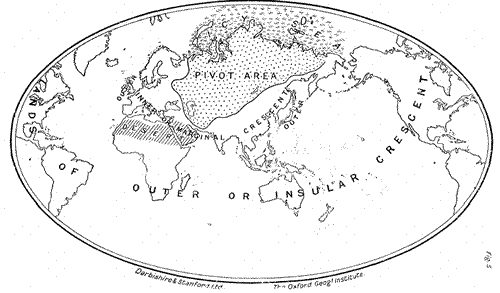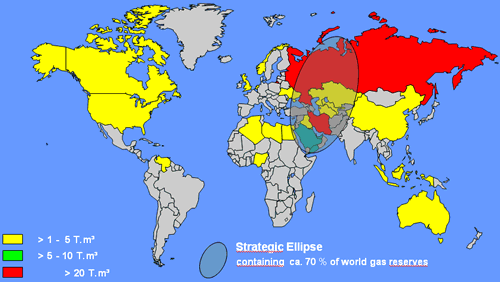
Introducing Timothy Boon von Ochssée
Timothy Boon von Ochssée is a researcher at the Clingendael International Energy Programme (CIEP) and works on a PhD about the global gas market.
Article
The US approach to containing Russia’s strategy as described in “Russia and the US in a New World Energy Order” (also published by ExloringGeopolitics) is not entirely new. It is based on geo-strategic thinking by Mackinder.
Mackinder theorized that the Eurasian landmass, should never be dominated by a single power or a coalition of powers and that a land power could always defeat sea power if this was allowed to occur[1]. The British admiral was therefore concerned that even the mighty British Navy would be no match for any power that dominates the Eurasian landmass, particularly through the construction of railways across the Eurasian landmass. Mackinder referred to a particular area on the Eurasian landmass that he deemed of critical geo-strategic importance, i.e., the ‘Pivot area’ (which coincides strongly with much of the post-Soviet space and the location of many of the world’s largest gas deposits today) surrounded by the ‘inner’ and ‘outer’ crescents, see Figure 1.
Prof. Spykman[2] later refined Mackinder’s strategy to adapt it to the new post-World War Two reality of the Cold War, doing so as early as 1944. Spykman came to the conclusion that the US was bound to face off with a strong Soviet Union on the Eurasian landmass in the aftermath of World War Two. The basic premise of Spykman’s geopolitical school of thought is that the balance of power in Eurasia directly affected US national security. Under President Truman, containing the Soviet Union became a top priority for US foreign and security policies in the late 1940s and early 1950s. Spykman reasoned that a prerequisite for the US to be able to maintain its supremacy in the world, just like the British Empire did before it, is developing a strong navy and maintaining a strong presence in what he called the ‘rimland’ (or Mackinder’s inner crescent) either through military outposts or pro-US allied governments.
The NATO alliance system hinges geographically on the Western portion of the landmass and constituted the western flank of the US containment effort. In the south lay the Middle East and the southern portion of Central Asia (as for the Gulf, for some time Iran was a pro-US ally under the Shah until the Islamic Revolution in 1979), and to the East lay Japan as well as other countries in the US camp as well as naval bases, all positioned, in fact, to prevent any one power in the pivot area from dominating the Eurasian landmass through the rimland. The result of this strategy or at least its purported goal was to prevent the heartland (or Mackinder’s pivot area) from being dominated by a single power or coalition of powers (just as Mackinder prescribed).

Figure 1: Mackinder’s ‘pivot area’, the ‘inner’ and ‘outer crescents’: Source: H.J. Mackinder, ‘The Geographical Pivot of History’, The Geographical Journal, vol. 24, no. 4, 1904, p. 435.
Containing Russia and developing alternative transport routes for Central Asian gas
The US wishes to prevent a strengthening Russia from resurging to great power status and it employs the expansion of non-state actors such as the EU and NATO (under the banner of democratic ideals such as ‘freedom’[3]) to reduce Russia’s ability to exert influence in the post-Soviet space. With its vast energy resources and lacking the appropriate tools of hard power, Russia is bent on employing its soft power as an energy broker (particularly with respect to gas) in order not only to exert influence but also to defend its interests in what it sees as an ongoing process of US expansionism. For Russia, the post-Soviet space (which includes the CIS countries) coincides with much of Mackinder’s pivot area and Spykman’s heartland. The Central Asian countries play a crucial role in Russia’s energy strategy, besides the fact that it sees this part of the post-Soviet space as part of its own sphere of influence.
Russia is currently involved in a complex game where it must balance security of demand in the medium- to long-term with essential Central Asian (primarily Turkmen) gas for domestic consumption as well as its own exports; while new gas provinces in Yamal and Shtokman remain difficult to fit into a production strategy[16]. Indeed, in order to resurrect its empire, Russia must reassemble the lost Soviet energy complex, for without those other bastions of raw materials – Kazakhstan, Uzbekistan and Turkmenistan – it can never be an energy superpower[17]. The concentration of the world’s gas reserves in the ‘strategic ellipse’ (see Figure 2 below) illustrates the geo-strategic significance of Spykman’s strategy as well as Russia’s energy strategy.

Figure 2: The strategic ellipse and the heartland. Source: BGR
Considering the above and the fashion in which Russia-US relationships are developing at present, US goals vis-à-vis Russia are appear two-fold:
- To prevent Russia from re-emerging as a superpower, while the US sees itself aims to protect its status as the world’s only hegemony.
- In support of 1), to undermine Russia’s ability to regain control of the post-Soviet space (the CIS countries) and contain its ability to exert influence on Europe.
- To chip away at Russia’s energy clout by promoting alternative routes of transport for natural gas from Central Asia through the Caucasus and Turkey as well as through Afghanistan.
The resulting geopolitical dynamics are not necessarily conducive to a situation of absolute gains and losses in a geopolitical contest between Russia and the US and/or the EU. Rather, the major actors are involved in a complex game of relative advantage, hinging on economic interdependence, geo-economic competition and shifting alliances. In this process of gamesmanship, pipeline routes and gas flows play a decisive role in determining the relative strength and bargaining power of all parties involved in the present and future international gas market.
In the ongoing process of containing Russia, and in wrestling key strategic areas away from its control, US policy has already had its tactical successes. These tactical successes are derived from the rimland strategy pursued by the US, one in which fragmenting the rimland becomes a key strategy in achieving the further containment and roll-back of Russian influence, in particular as far as oil and gas flows are concerned. Georgia and Azerbaijan, for example, have expressed their interest for joining the pro-NATO camp. The pattern emerging from the current US containment strategy is as follows, split into three-phases:
- Tie former Soviet states into its sphere of influence, primarily under the banner of the ‘war on terror’, e.g., Georgia and Azerbaijan.
- Establish a military presence in Central Asian countries such as Kyrgyzstan (and Uzbekistan, though the US was evicted there in July 2005), and more recently Afghanistan.
- Promote the development of new pipeline routes for oil and gas from Central Asia and the Caspian Sea through the Caucasus and on to Turkey, as part of a strategy to undermine Russia and decrease oil supply reliance on the Persian Gulf region.
The exponent of this approach thus far is the Baku-Tblisi-Ceyhan (BTC) pipeline, built to transport oil from the Caspian Sea, at Baku, to an oil terminal in Ceyhan, Turkey. The pipeline avoids Russian as well as Iranian territory and enhances Western, particularly European, energy security. Just as the BTC pipeline carries Caspian oil from Azerbaijan to the Mediterranean, there are other transport routes which already exist on paper designed to transport natural gas from the region. A brief list follows below:
- The NABUCCO pipeline: Starting from Azerbaijan and perhaps Iran (both Russia as well as the US wish to avoid seeing Iranian gas reach Europe)
- The South Caucasus pipeline (SCP): Designed to feed into the NABUCCO pipeline to transport Caspian gas from Azerbaijan (parallel to the BTC pipeline).
- The Trans-Caspian pipeline: Originating in Turkmenistan and transiting the Caspian Sea, feeding into the SCP at Shah Deniz (a gas field offshore in Azeria waters in the Caspian Sea.
- The Trans-Afghanistan pipeline: Originating in Turkmenistan, potentially bringing Turkmen gas to Pakistan through Afghanistan.
All four routes have several common denominators:
- They skirt Russian and Iranian territory, just as the BTC pipeline does for oil.
- Specifically also, they imply a zero-sum type loss to Russia when it is taken into consideration that gas volumes traveling through these routes (from Turkmenistan, Kazakhstan and Azerbaijan, primarily) will not travel via Russia. Russia needs as much Central Asian gas as it can obtain for own consumption and to bolster its ability to maintain exports to Europe. Therefore, developing alternatives for Central Asian gas can only undermine its energy clout.
The peculiar aspect of this evolving situation is that the US does not even import any natural gas beyond Canada and Trinidad and Tobago. The pipelines mentioned above all strengthen European gas supply security while the US is more concerned, with respect to its own energy security, about oil in the Central Asian and Persian Gulf regions. The strategy described above thus has an unambiguous set of goals: to undermine Russia’s energy strategy by attempting to divert Central Asian gas volumes. The ultimate result of the implementation of these alternative routes is that Russia’s potential as a regional hegemony on the Eurasian continent is diminished.
Footnotes
[1] H.J. Mackinder, ‘The Geographical Pivot of History’, The Geographical Journal, vol. 24, no. 4, 1904, pp. 421 – 437.
[2] Nicholas Spykman was a Dutch American geo-strategist, known as the ‘godfather of containment’. See N.J. Spykman, The Geography of the Peace, (New York: Harcourt, Brace and Company, 1944)
[3] The White House officially described Bush’s last trip to the Baltic countries in November 2006 as being in “support the advance of freedom and to strengthen the NATO Alliance.” See http://www.whitehouse.gov/news/releases/2006/09/20060907.html
[4] C. van der Linde, ‘Een nuttig reisje’ (‘A useful trip’), EnergieNed, May 2007.
[5] A. Rahr, ‘The New OPEC,’ Internationale Politiek, Spring 2006, p. 69.
